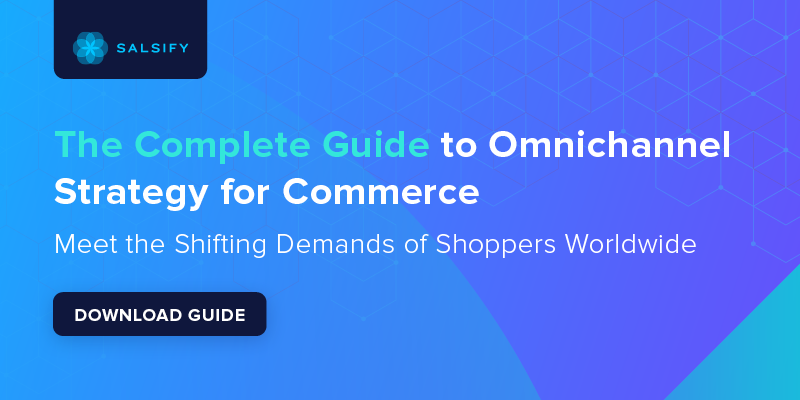

Here’s How To Build a Killer Omnichannel Commerce Strategy
Make the most of your omnichannel ecosystem with Salsify’s “Compete Guide to Omnichannel Strategy for Commerce.”
DOWNLOAD GUIDEPIM
Manage all product content in one central system of record.
Syndication
Easily syndicate product content to every consumer touch point.
Enhanced Content
Enrich product pages with below-the-fold content and rich media.
Intelligence Suite
Bring AI-powered capabilities directly into your Salsify workflows.
Grocery Accelerator
Leverage the first-ever category-wide PXM accelerator in the grocery industry.
GDSN Data Pool
Synchronize standard supply chain, marketing, and ecommerce attributes globally.
Digital Shelf Analytics
Continuously optimize your organization’s product content syndication.
Catalog Sites
Share secure, on-brand, and always up-to-date digital product catalogs.
Automation and AI
Automate business processes and enhance Salsify workflows with AI.
PXM Platform, Integrations, and APIs
Integrate the PXM platform with the rest of your enterprise systems architecture.
Supplier Onboarding
Accelerate supplier onboarding while ensuring your schema requirements are met.
Product Listing
Sell products faster with Product Listing.
Content Enrichment
Increase online conversions with Content Enrichment.
Automation
Save time and increase operational efficiency with retail automation.
SXM Platform, Integrations, and APIs
Integrate the SXM platform with the rest of your enterprise systems architecture.
Syndication Network
Automate how you exchange product content data to the digital shelf.
Enhanced Content Network
Turn product pages into product experiences with Enhanced Content.
Commerce Platform Integrations
Create winning product experiences everywhere shoppers are, including on owned sites.
GDSN Data Pool
Synchronize standard supply chain, marketing, and ecommerce attributes globally.
Open Catalog
Connect to the digital shelf faster with an open, standardized, and free product catalog.
Resources
Resource Library
Explore our ecommerce resources to get everything you need to win on the digital shelf.
Blog
Read our blog to get actionable insights for navigating changing markets and industry demands.
Webinars
Watch our on-demand ecommerce webinars to gain expert advice and tips from our community of industry leaders.
Customer Blog
Gain the latest tips, industry trends, and actionable ecommerce insights.
Knowledge Base
Investigate our knowledge base to build your Salsify skills and understanding.
API
Examine our comprehensive API and webhook guides to start working with Salsify quickly.

Download the report to get expert insights, consumer research, and top industry trends.

Customers want the ability to connect with brands whenever, wherever, and however they prefer. This is omnichannel — and creating an omnichannel ecosystem is now critical to driving product and retail brand success.
Consider data from Statista, which found that 64% of customers prefer emails as their primary method of brand contact, followed by websites and applications at 47%, and social media at 36%, while phone calls and text messages rounded out the list at 30% and 28%, respectively.
The message is simple: More support for more channels makes it easier for customers to get in touch, increasing brands’ ability to engage potential buyers, driving them to product pages, and helping them make the move from curiosity to conversion.
Here’s a breakdown of the basics of an omnichannel ecosystem, its benefits (and potential challenges), its role in helping brands better understand customers, and what steps companies can take to build effective omnichannel experiences.
Omnichannel ecosystems allow customers to get in touch with brands using the channels they prefer rather than a set of pre-defined touch points.
For example, a retail brand that only offers email and phone channels has a dual-channel ecosystem, meaning they miss out on the potential to connect with customers via social media sites or text messaging. Omnichannel frameworks, meanwhile, don’t limit contact options based on channel type. Instead, they focus on connecting new channels with existing ecosystems to increase consumer choice.
Creating an omnichannel ecosystem offers significant benefits for brands but also comes with potential challenges.
The omnichannel model has some major advantages.
Omnichannel capabilities help improve the customer experience. Consider data from Hootsuite, which found that 62.3% of Instagram users research brands and products on the platform, and 69% of Facebook users make purchases after seeing personalized content.
In isolation, both of these channels offer revenue opportunities. In conjunction, they boost brand consistency and improve the customer experience by making it easier for users to find what they want.
According to research from Springer, brands that extend their omnichannel strategies to include price, service, and delivery collaboration “positively affect the omnichannel shopping experience and customer loyalty.”
Every time a customer can’t complete an action using their current channel or has to repeat their issue to another customer service agent, friction increases. Too much friction and customers will take their business elsewhere.
Omnichannel ecosystems make it possible for companies to connect the dots of customer interactions, in turn reducing friction. For example, if customers submit an email ticket about a product issue and then call to follow up, an omnichannel approach allows companies to ensure initial ticket data is entered into customer relationship management (CRM) systems which can then be accessed by agents when customers reach out.
Your blind spots can hurt your bottom line. As a result, effective omnichannel implementation requires visibility across customer-facing channels, such as social media, and internal channels, including supplier portals and inventory management.
Omnichannel ecosystems depend on the availability of data. In practice, this requires companies to implement solutions capable of collecting and correlating different data types, including call recordings, text messages, and form submissions.
The goal of omnichannel is to improve both the customer experience and the business’s bottom line. But this isn’t possible without the right metrics — companies need to decide what they want to measure, how they want to measure it, and which data sources to use.
For example, if the metric being measured is the total number of new website visitors, businesses need to capture all visitor sources — from social links to search results to directly entered URLs — to understand which channel is driving the most traffic and which need to improve.
According to data from Salesforce, 92% of potential buyers and existing customers now expect a personalized experience.
It makes sense: If consumers are willing to share both personal and purchasing data with companies, they want something in return. More specifically, they want emails, offers, and customer service tailored to their needs and based on their history with the company.
Omnichannel ecosystems can help boost organizations’ ability to understand their customers by providing a host of data about how, when, and where customers connect.
Consider a brand looking to boost overall sales volumes. If omnichannel data reveals that a significant number of customers are using mobile devices to access brand websites, but these devices are designed for desktop users, this speaks to the need for site upgrading to capture a larger market share.
The collection of omnichannel data also enables per-customer hyper-personalization. For example, if data reveals a customer preference for buying items in bulk and shows their preferred channel method is emails, companies can create and deliver targeted email ads for these customers that offer discounts on products they’ve purchased in the past.
Based on the brands’ target audience and market goals, the omnichannel environment will differ. As a result, there’s no one-size-fits-all approach to creating effective ecosystems.
Three tips, however, can help brands start strong.
Not all channels are created equal. As noted above, many consumers prefer email as their primary contact channel. But it’s also worth considering more granular priorities — while some customers may prefer website channels, which channel is the most popular?
For example, product brands may discover that customers are more likely to visit retail brand partner sites or sites like Amazon rather than viewing brand websites directly.
By incorporating this channel data, brands can increase the reach of their omnichannel efforts.
Omnichannel ecosystems are naturally broad — the more channels, the better when it comes to connecting with customers. But this same scope can prove problematic when brands look to target and improve key metrics.
As a result, it’s worth targeting and measuring specific outcomes, such as increased traffic from a channel source or increased conversions tied to personalized marketing connected to a preferred customer channel.
To effectively roll out omnichannel, brands need tools capable of managing, delivering, measuring, and monitoring content and connections across email, text, phone, social, and other channels simultaneously.
Omnichannel isn’t going anywhere. Consumers now expect to connect with brands wherever, however, and whenever they want — and businesses that don’t keep pace will be left behind.
As a result, there’s never been a better time to build (or bolster) your omnichannel strategy.

Make the most of your omnichannel ecosystem with Salsify’s “Compete Guide to Omnichannel Strategy for Commerce.”
DOWNLOAD GUIDEDoug Bonderud (he/him) is an award-winning writer with expertise in ecommerce, customer experience, and the human condition. His ability to create readable, relatable articles is second to none.
Standing out on the digital shelf starts with access to the latest industry content. Subscribe to Below the Fold, our monthly content newsletter, and join other commerce leaders.